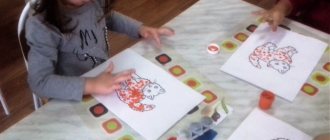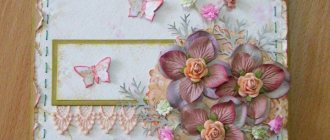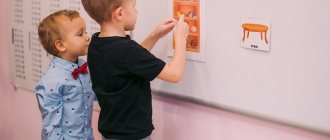Summary of GCD in the 2nd junior group: Wild animals
GCD in the second junior group of kindergarten
Objectives: Educational:
To consolidate children's knowledge about wild animals, their appearance, and the peculiarities of their habits.
Fix the names of the cubs. Specify the name of the dwelling. Consolidate knowledge about basic geometric shapes (circle, square, triangle); about the primary colors (red, blue, yellow, green) and shade - gray. Developmental:
Develop coherent dialogical speech, the ability to coordinate different parts of speech.
Develop attention, memory, thinking. Develop children's creative abilities; Ability to work neatly and cleanly with paints. Educational:
Foster love for the world around us;
Feeling of compassion, desire to help; Cultivate neatness and cleanliness. Equipment:
“Forest” decoration, supplies of squirrels and mushrooms. Slideshow on the projector “Inhabitants of the Forest” For each child, a landscape sheet with the image of a white hare, gray gouache paints, cotton swabs, napkins.
Progress of activities
V.: What a good day today, guests have come to us, let's say hello the way we know how: “Hello, palms - clap, clap, clap. Hello, legs - top, top, top. Hello, cheeks - splash, splash, splash. Round cheeks - splash, splash, splash. Hello, sponges - smack, smack, smack. Hello, teeth - click, click, click. Hello, my nose is bi, bi, bi. Hello, dear guests - hello. Mail: “Come urgently, help urgently! Miracles happen, we cannot divide the forest. The wizard scared us, he bewitched us all. We have forgotten who we are, what we should drink and what we should eat. Help us out, come and make peace between us urgently!” Forest inhabitants. Q: What are the names of the animals that live in the forest? (wild) Q: What wild animals do you know? Q: Why are they called wild? V.: some wizard bewitched all the animals, now they don’t know who they are, what they should eat, where to live, and most importantly, they don’t recognize their cubs. They ask us for help, shall we help? Q: But what can you use to go into the forest? Let's remember what types of transport we know. V.: They travel long distances by plane, the train travels on rails, they sail on the sea by ship, few people can fit in the car. Q: Are there many of us or few? Q: There are a lot of us, and the forest is not far, what can we all ride at the same time? V.: To go by bus, you need to buy tickets and sit in the place where the same figure of the same color is depicted (geometric shapes are glued to the chairs: a square, a circle and a triangle in red, yellow, blue and green colors) An inspector comes in and checks randomly tickets. The song “Bus” by V. sounds: it seems that we have arrived, listen to how the birds sing, how it smells in the forest. It’s very beautiful here, but I don’t see a single forest dweller. The animals are probably very confused, because they have forgotten who they are. 1 slide. Bear.
- who is this? -Tell me, children, what kind of bear is it? (big, brown,
kind, he has powerful paws, small ears) - what is the name of the cub? -What does he like to eat? - but in winter there is no honey and berries, what does the bear do? -Where does he sleep? 2 slide. Bear in a den.
V.: Oh, look, under the bush, under the bush there is Someone with a red tail. Who do you think it is? , 3rd slide Fox.
Q: Look at the fox and tell me what it is like. The fox is red, beautiful, cunning. She has a fluffy, long tail. She is often called plutovka, which means a deceiver. The fox does not change its coat; it is red both in summer and winter. -What is the name of the cub? 4 slide. Nora.
There is a fox's house under the bush. What is the name of the fox's house? V.: The entrance to the hole is narrow, long, and inside the hole is spacious and comfortable. Q: Who knows why the fox needs such a fluffy tail? (cover tracks) V.: let’s show together how a fox walks and covers its tracks. Physical exercise. The fox walked through the forest, made song calls, the fox tore the stripes, the fox wove bast shoes, walked near the Christmas tree, and what did you find on the Christmas tree? Mushrooms? Q: Do mushrooms grow on the Christmas tree? Q: What grows on the Christmas tree? (cones and needles)Where do mushrooms grow? (on the ground) V.: then whose mushrooms are these? (squirrel reserves) Where is the squirrel itself? 5 slide. Squirrel
V.: here she looks at us and asks for help, because she has forgotten who she is. Come on, guys, we'll tell you about her. What kind of coat does a squirrel have? (red, fluffy) Ears, tail? What is a baby squirrel called? (little squirrel) What is the name of her house? (hollow) 6 slide. Squirrel in a hollow.
V.: squirrels make themselves a house high in a tree. Let's show together how high it is. (We stand on our toes) Q: Why do you think the squirrel’s house is so high? (so that other animals cannot get to her or her supplies) V.: All animals have their own houses: the bear has a den, the fox has a hole, the squirrel has a hollow, but where does the hare live? What kind of house does he have? V.: The bunny doesn’t have a house, he slept under a bush and ran away, so he runs fast because there is nowhere to hide. Slide 7 The hare is white.
V.: Here is the bunny, let's look at it together. What kind of ears, tail, fur coat does he have? V.: The hare is a real fashionista: in winter he wears a white fur coat, and in summer he wears a gray one. Why do you think? (to make it easier to hide) Oh, trouble! It’s already spring, but the hare still hasn’t changed his coat, we need help. Painting a white hare gray (using the “poking” method with cotton swabs) 8 slide . The hare is gray.
V.: Look, the hare is already gray, we helped him. Great job guys, well done! Oh, he's already galloped away. Slide 9 Wolf
V.: Another resident showed up. Gray, scary and toothy. Caused a commotion. All the animals ran away. Scared the animals... V.: tell me what he is like? Slide 11 Lair.
V.: The wolf also has a home, look at what it is like. His home is called a lair. Sad music sounds and a wizard appears. V.: wizard, what happened, why are you so sad? Wizard: Yesterday I accidentally bewitched all the animals in the forest. I can’t cast the spell back - I forgot the words. V.: Don’t worry, wizard, we have already helped all the animals. We reminded them who they are, where they live and what they like to eat. V.: Guys, let's tell the wizard what animals we helped. Wizard: Thank you very much, you helped me out so much. Who are you and where did you come from? (from kindergarten) Wizard: what are you doing there? Show how you can dance. Dance “Stamp, my foot” Wizard: my time has come to please you. Close your eyes. The wizard says special words and a huge candy appears. Q: How can we share one candy among everyone? The wizard once again asks you to close your eyes, casts a spell, and many small ones appear from the large candy. The wizard thanks for the help and leaves. V.: oh, guys, it’s already very late, it’s time to go back. The bus ride will be long, so we will return to the group by plane. V.: they started the engines, spread their wings and flew.
We recommend watching:
Summary of GCD for children of the 2nd junior group on the topic: Winter Summary of GCD cognition using ICT in the 2nd junior group. Journey to the autumn forest Lesson notes. Walk through the forest. Senior group About animal houses for preschoolers
Similar articles:
Conversation about the hare for older preschoolers
What can you tell children about a hedgehog?
A story about a squirrel for 1st grade children on the world around them
What can you tell children about the fox?
Conversation about the wolf. Senior - preparatory group
PROJECT IN THE SECOND JUNIOR GROUP “In the animal world”
Municipal budgetary preschool educational institution
general developmental kindergarten with priority implementation
cognitive and speech development of children No. 28 “Spikelet”
Educators:
Zimova M.N.
Sinenko S.S.
Essentuki 2021
PROJECT PASSPORT:
1. Topic: In the animal world. 2. The project was implemented by teachers of the 2nd junior group No. 2: Zimova M.N., Sinenko S.S. 3. Type of project: educational-game, creative; by number of participants: group 4. Project participants: children of the 2nd junior group No. 2, group teachers, parents of students. 5. Project duration: short-term – 2 weeks.
RELEVANCE OF THE PROJECT ON THE PROPOSED TOPIC
It is important to start cultivating a love for nature from childhood, to teach how to care for nature and protect it. An important part of nature are living beings. First of all, the child gets to know the animal world by getting to know those who live next to him. And these are domestic and wild animals.
The animal world is extremely attractive; animals in the house are an important factor in education. This is not surprising, because every mother and every father wants their children to be kind, warm-hearted, and responsive. According to the scientist, “A person who does not love animals, who has never shown concern for them, cannot be kind.”
But, unfortunately, not every child has an animal at home, and not every child’s parents go to the zoo or go out into nature. Therefore, there was a desire to introduce children more closely to domestic and wild animals.
Objective of the project:
Enrich and expand the knowledge of preschool children about wild and domestic animals.
Project objectives:
- Teach children to identify the difference between domestic and wild animals by their habitat.
- Learn to recognize and name wild and domestic animals by appearance.
- Give an idea of what they eat, how and where domestic and wild animals live.
- To develop the ability to distinguish between animals and their young, to imitate their voice.
- Develop skills in writing short stories about animals.
- Learn to convey the habits of animals in movements and gestures, develop all types of motor skills.
- To develop children's interest in nature and emotional responsiveness.
- To develop children's interest in oral folk art, Russian folk tales about animals.
- Develop thinking, imagination, memory, enrich vocabulary.
- To instill in children a love for animals and a caring attitude towards them.
- Reinforce the rules of safe behavior when interacting with animals.
Expected results of the project:
- Children will understand the difference between domestic and wild animals.
- They will learn to name the animal and its baby.
- They will be able to determine the habitat of animals, their distinctive features and habits.
- They will begin to realize the benefits that animals bring to humans.
- They will follow basic rules of behavior with animals.
Project implementation stages
Preparatory stage:
- Determining the level of children's knowledge about domestic and wild animals.
- Defining the project theme, objectives, strategies and mechanisms.
- Selection of children's fiction.
- Selection of subject pictures, illustrations about animals.
- Production of teaching aids on the topic.
- Selection of methodological literature, riddles on the topic, presentations for conducting educational activities.
Main stage:
Conversations:
“On the farm”, “How we take care of pets”, “The dog is our best friend”, “Forest inhabitants”, “Moms and their cubs”, “Rules for visiting the forest”, “How wild animals winter”, “Do not touch unfamiliar animals!”, “We are responsible for those we have tamed.”
Reading fiction:
“Horse” by A. Barto, A. Blok “Bunny”; S. Marshak “The Tale of a Stupid Mouse”; Russian folk tales: “Kolobok”, “Three Bears”, “Wolf and Seven Little Goats”, “Fox, Hare and Rooster”, “Teremok”, “Zayushkina’s Hut”, “Rukavichka”, “Goat - Dereza”, “Rooster and fox", "Tili - bom".
Songs - nursery rhymes:
“Dance the little bunny,” “Like our cat,” “The squirrel is sitting on a cart.”
Writing a story:
“Like a kitten washed itself”; “Like a hare crossed the road”; “My favorite toy is the believer.”
Quiz
: "Domestic and wild animals."
Didactic games:
“Three Bears”, “In our yard”, “Who eats what”, “Domestic or wild animal”, “Name the family”, “Who lives where?”, “Guess who it is?”, “Agree and repeat” , “Whose tail, whose body, whose head, whose ears?”, “Which, which, which?”, “Whose tail?”
Role-playing games:
"Journey to grandma's village." “Let's visit the zoo”, “Veterinary hospital”, “On the farm”, “In the forest”.
Outdoor games:
“Shaggy Dog”, “Mice Dance in a Round Dance”, “Goat-Dereza”, “Geese-Geese”, “By the Bear in the Forest”, “Bunnies”, “Horses”, “Cat and Mice”, “The Little White Bunny Is Sitting”.
Finger games:
“Kittens”, “Once upon a time there was a bunny”, “In the forest”.
Productive activities:
Coloring:
Coloring pages for kids from the series “Pets” and “Wild Animals”.
Drawing:
"Chicks";
Application:
"Lamb";
Modeling:
“Piglet”, “Mushrooms and nuts for a squirrel”
Design:
"Barnyard"; "Den"
The final stage:
Project products:
- Exhibition of productive activities on the topic of the project.
- Exhibition of educational and fiction literature about animals.
- Making the album: “Animals around us”
- Creating a layout: “Farm Yard”
As a result of the work, the children learned to understand that domestic animals play an important role in nature and in human life. Learned how to care for pets. They know what role wild animals play in nature. Also, children’s vocabulary will be enriched, their communication and creative abilities will expand, and a strong interest in representatives of the animal world will arise.




